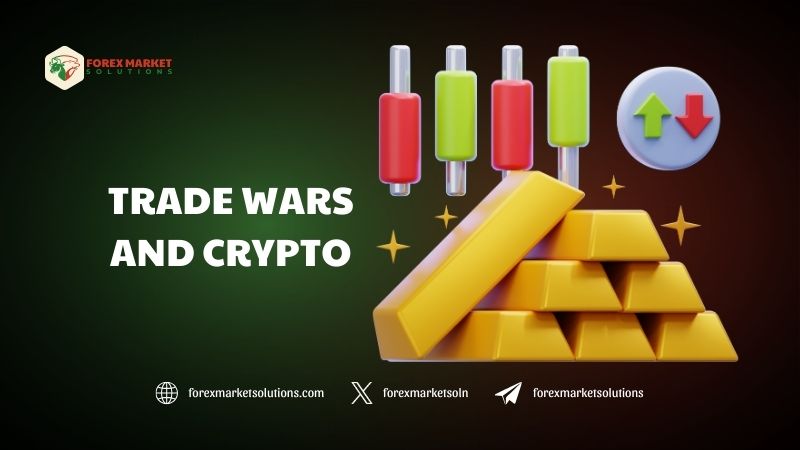The intersection of geopolitics and finance has always been a volatile space, but in recent years, few topics have stirred markets as much as trade wars and crypto. As nations impose tariffs, restrict exports, and flex economic muscle, the ripples extend far beyond traditional assets, influencing the decentralized world of cryptocurrencies. In 2025, with global trade tensions simmering—think US-China rivalry or EU protectionism—the crypto market feels the heat, offering both risks and opportunities for traders and investors. This dynamic interplay between trade wars and crypto shapes price movements, investor sentiment, and the broader financial landscape, making it a critical area of focus for anyone engaged in digital assets.

Trade wars, historically fought with tariffs and quotas, now intersect with the rise of blockchain technology, creating a unique battleground where centralized policies clash with decentralized currencies. Bitcoin, Ethereum, and emerging altcoins respond to these conflicts in ways traditional markets don’t, driven by their borderless nature and speculative appeal. For those navigating this terrain in 2025, understanding trade wars and crypto is not just an academic exercise—it’s a practical necessity to anticipate volatility, seize opportunities, and manage risks. This comprehensive guide dives into how trade disputes influence cryptocurrencies, offering insights into their evolving relationship and strategies to thrive amid the chaos.
The Roots of Trade Wars and Their Modern Evolution
To grasp the connection between trade wars and crypto, it’s worth tracing the origins of trade conflicts. Trade wars arise when nations impose barriers—tariffs, sanctions, or export bans—to protect domestic industries or retaliate against perceived unfair practices. The US-China trade war, ignited in 2018 with tariffs on billions in goods, set a modern precedent, disrupting supply chains and rattling markets. By 2025, this rivalry persists, fueled by tech competition—think semiconductors and AI—while new fronts, like EU tariffs on Chinese electric vehicles, add complexity.
These disputes ripple through economies, affecting currencies, stocks, and commodities. Traditional safe havens like gold or the US dollar often strengthen as investors flee uncertainty, but the decentralized nature of cryptocurrencies introduces a wildcard. Bitcoin, launched in 2009 amid the Global Financial Crisis, was born from distrust in centralized systems—a sentiment that resurfaces during trade tensions. In 2025, with nations wielding economic weapons, the stage is set for trade wars and crypto to intertwine, as investors seek alternatives beyond government-controlled assets.
The evolution of trade wars now includes digital fronts. Restrictions on tech exports—like US limits on Huawei—impact blockchain development, while sanctions on nations like Russia push them toward crypto for cross-border payments. This shifting landscape amplifies the relevance of trade wars and crypto, blending old-school economics with new-age finance.

How Trade Wars Influence Crypto Markets
The relationship between trade wars and crypto manifests in distinct ways, driven by market psychology and macroeconomic forces. When tariffs escalate—say, a 25% US levy on Chinese imports—global growth slows, eroding confidence in fiat currencies tied to affected economies. The Chinese Yuan (CNY) might weaken, prompting investors to hedge with Bitcoin or stablecoins like USDT, which thrive in uncertainty. In 2025, with trade spats disrupting supply chains, crypto’s appeal as a “digital gold” grows, lifting prices during initial panic.
Conversely, trade wars can depress crypto markets indirectly. A prolonged US-China conflict might crash stock indices, triggering risk-off sentiment where investors dump speculative assets—including altcoins—for cash or bonds. Ethereum, tied to DeFi and NFT ecosystems, could dip if trade-driven recession fears sap liquidity. Yet, Bitcoin often decouples, rising as a store of value when fiat falters, a pattern seen in past tensions and likely in 2025’s volatile climate.
Sanctions add another layer. When the US restricts Russian banks, Moscow turns to crypto for trade settlements—evidenced by 2022’s surge in BTC/RUB volume. In 2025, as trade wars expand—perhaps India vs. China over tech—these workarounds boost crypto adoption, driving demand. This dual nature of trade wars and crypto—a mix of haven appeal and risk sensitivity—creates a complex but tradable dynamic.
Trade Wars and Crypto: Opportunities and Risks
Navigating trade wars and crypto in 2025 offers traders a chance to capitalize on volatility, but it demands strategy and caution. One opportunity lies in Bitcoin’s safe-haven status. During a tariff escalation—imagine the EU slapping duties on US tech—BTC/USD might spike as investors flee weakening euros or dollars. A trader could buy Bitcoin at $60,000, setting a stop-loss at $58,000 and targeting $65,000, riding the uncertainty wave. Historical rallies—like 2019’s climb amid US-China talks—suggest this pattern holds, amplified by 2025’s institutional crypto adoption.
Altcoins present another angle. A trade war boosting crypto-friendly policies—like Japan embracing blockchain to counter China—could lift coins like Cardano or Solana. Spot these shifts via news or on-chain data (e.g., wallet activity), entering at support levels with tight stops. In 2025, with DeFi growing, such coins might outpace Bitcoin during trade-driven regulatory pivots.
Risks loom large, though. A severe trade war—say, a US-China tech ban—could tank global markets, dragging crypto with it as liquidity dries up. Stablecoins tied to fiat, like USDC, might wobble if dollar confidence shakes, while overleveraged traders face margin calls. Hedging with short positions on altcoin futures or holding cash mitigates this, balancing the upside of trade wars and crypto with downside protection.

Crypto’s Role in Bypassing Trade Barriers
Beyond price action, trade wars and crypto intersect through practical use. Cryptocurrencies excel at dodging traditional barriers—tariffs don’t apply to BTC transfers, and sanctions can’t stop peer-to-peer trades. In 2025, nations under pressure—like Iran or Venezuela—lean on crypto to import goods, paying suppliers in Bitcoin or Monero to skirt SWIFT bans. This utility drives adoption, pushing prices as demand rises.
Businesses follow suit. A Chinese firm facing US export curbs might settle with an EU partner in Ethereum, bypassing dollar-based banks. Blockchain’s transparency—via public ledgers—ensures trust, while privacy coins add secrecy. In 2025, with Central Bank Digital Currencies (CBDCs) like China’s e-CNY competing, crypto’s borderless edge in trade wars and crypto grows, reshaping global commerce.
Traders can monitor this via volume spikes in restricted regions or news of crypto-friendly trade deals. A surge in BTC/CNY trades might signal China stockpiling crypto, hinting at a bullish move—a subtle but powerful cue.
Strategies for Trading in 2025
To thrive amid trade wars and crypto, blend technicals with fundamentals. Use platforms like TradingView to spot patterns—say, a Bitcoin breakout above $62,000 after a tariff announcement—pairing it with RSI or MACD for confirmation. Set alerts for key levels, entering with 1:2 risk-reward ratios (e.g., risk $500 to gain $1,000). In 2025’s algo-driven markets, timing is critical—trade news-driven spikes fast.
Fundamentals matter too. Track trade war developments—US-China talks, EU quotas—via economic calendars or Bloomberg. A dovish resolution might cool crypto’s haven appeal, while escalation fuels it. Diversify—hold Bitcoin for stability, altcoins for growth, and cash for dips—balancing trade wars and crypto exposure. Avoid overleveraging; a 5:1 ratio keeps you safe in sudden crashes.

Mastering the Chaos
The nexus of trade wars and crypto defines a thrilling frontier in 2025, where tariffs meet blockchain, and uncertainty breeds opportunity. From Bitcoin’s haven status to altcoins’ speculative swings, trade disputes shape crypto in unpredictable ways. By understanding this interplay—riding rallies, hedging risks, and leveraging crypto’s utility—you can turn global tensions into trading wins. In a year of flux, trade wars and crypto offer a lens to see markets anew, blending geopolitics with digital innovation.
Ready to conquer this landscape? Follow Forex Market Solutions for expert crypto insights and strategies to excel in 2025 and beyond.
